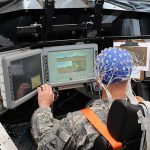
“Power is in tearing human minds to pieces and putting them together again in new shapes of your own choosing.”
Advances in Neuroscience and technology (NeuroS/T) are bringing this capability to the brink of reality. The Future Operational Environment (OE) will not be limited to conflict in the land, sea, air, cyber, and space domains.  Direct attacks upon, and the manipulation of, Soldiers’ and noncombatants’ brains represent a significant threat, challenge, and opportunity in neurotechnology. The human brain will be a specific target of Multi Domain Battle.
Direct attacks upon, and the manipulation of, Soldiers’ and noncombatants’ brains represent a significant threat, challenge, and opportunity in neurotechnology. The human brain will be a specific target of Multi Domain Battle.
At the Visualizing Multi Domain Battle 2030-2050 Conference, Georgetown University, 25-26 July 2017, Dr. James Giordano, Chief of the Neuroethics Program at Georgetown University,  explained how neuroscience has made huge leaps by using technology to study and understand how the nervous system is structured and functions. NeuroS/T puts the brain at our fingertips, enabling us to better understand it.
explained how neuroscience has made huge leaps by using technology to study and understand how the nervous system is structured and functions. NeuroS/T puts the brain at our fingertips, enabling us to better understand it.
This knowledge provides the potential for new and exciting ways to improve our memories, expand our cognitive abilities, and even repair damaged brains; conversely, it also presents new vulnerabilities that technologies can target and exploit.
For operators/warfighters, these include a number of “weapons” of choice that facilitate neuro-enablement:
 • Advanced neuro-psychopharmacologics
• Advanced neuro-psychopharmacologics
 • Computational brain-machine interfaces
• Computational brain-machine interfaces
 • Closed-loop brain stimulation approaches
• Closed-loop brain stimulation approaches
 • Neuro-sensory augmentation devices
• Neuro-sensory augmentation devices
While they are not traditional weapons like guns, missiles, or blades, these technologies will make warfighters more lethal, aware, resilient, and integrated with their combat systems.
On a darker note, novel neuroweapons will grant adversaries (and perhaps the United States) the ability to kill, disrupt, degrade, damage, and even “hack” human brains to influence populations, bring about confusion and panic, and disrupt an enemy’s government and society, often without mass casualties. As such, they constitute avenues of attack against the human brain, facilitating personalized warfare. Neuroweapons are “Weapons of Mass Disruption” that may characterize major segments of warfare in the future.
NeuroS/T provides a number of novel neuroweapons, including:
• Pharmaceuticals and organic neurotoxins (i.e., ultra-low dose/high specify agents for use in targeting diplomatic/local culture “hearts and minds” scenarios)


• High morbidity neuro-microbiologic agents (i.e., neuro-microbials with high neuro-psychiatric symptom clusters for public panic/public health disintegrative effects)


• Gene-edited microbiologicals with novel morbidity/mortality profiles

• Nano-neuroparticulate agents: high central nervous system (CNS) aggregation lead/carbon-silicate nanofibers (network disrupters); neurovascular hemorrhagic agents (for in-close and population use as “stroke epidemic” induction agents).


These capabilities afforded by neuroweapons and NeuroS/T bring with them a host of ethical and moral considerations and conundrums. We must address whether affecting someone’s brain purposely, even temporarily, violates ethical codes, treaties, conventions, and international norms followed by the United States military.
• Does current policy adequately address the roles and responsibilities of commanders and individual soldiers in their employment of such weapons?
• If you influence or impact human brains without causing death or physical pain, is this still an act of war or belligerence?
• How do we ensure our warfighters maintain a robust defense against and remain resilient in the face of neuro threats?
What is clear is that the United States must explore not only what is possible, but what is justified, appropriate, and legally possible in the Battle of the Brain.

For more information on this topic, please see the following presentations by Dr. Giordano:
• Neurotechnology in National Security and Defense, from this past summer’s Georgetown University Conference
• Neuroscience and the Weapons of War podcast, with Mr. John Amble, on Modern War Institute (MWI), 02 Aug 17



• Does current policy adequately address the roles and responsibilities of commanders and individual soldiers in their employment of such weapons? Some of this probably verges on illegal under current policy and treaties, not that our enemies will respect that. Affecting the brains of potential adversaries is such a complicated issue, because if you achieve it by chemicals or biologicals it is prohibited, but if you achieve it by other vectors, it is probably OK. But it should be a topic of research and discussion.
• If you influence or impact human brains without causing death or physical pain, is this still an act of war or belligerence? Yes of course.
• How do we ensure our warfighters maintain a robust defense against and remain resilient in the face of neuro threats? Robust research. And defense for the greater population as well.
A very interesting post. I too am of the opinion that the integration of human and machine is inevitable, including direct integration of machines with the human brain. I anticipate such advancements will begin as means of combatting diseases such as Alzheimer’s, or traumatic injuries or handicaps, but eventually will move into providing performance advantages that will entice, if not practically self-mandate, adoption within society.
Imagine I could safely (and without side effects) implant a microchip into your brain that will grant you perfect memory recall and/or the ability to perform complex mathematical computations at the speed of a computer (think having MATLAB and the entire encyclopedia in your head). How many would want such a capability? Moreover, would those who don’t want it be able to compete without it?
As the author points out, this avenue opens new potential attack vectors that could target these integrated technological components in ways and with repercussions that are hard to even imagine today. I do somewhat disagree with the statement “On a darker note, novel neuroweapons will grant adversaries … the ability to … “hack” human brains to influence populations, bring about confusion and panic, and disrupt an enemy’s government and society, often without mass casualties” only in the sense that this can be done today, and has been done for quite some time. Not by actual physical “hacking”, of course, but information operations and misinformation campaigns have shown to be quite effective at causing large scale panic and confusion. One needs only look at the US response to the Ebola outbreak of 2014 to see how readily susceptible to fear the mass populace can be.